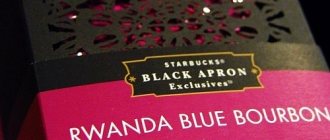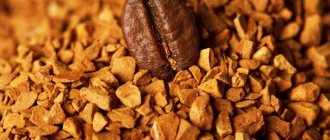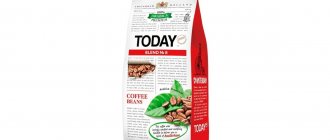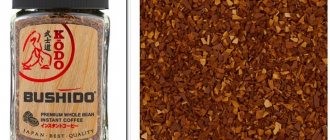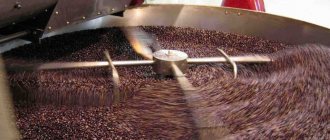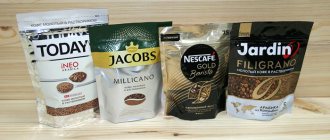Maybe it’s a matter of drinking culture, or maybe a simple lack of time? Nevertheless, we decided to find out the composition of one of the most common instant coffees - Nescafe .
The head of the nutrition and marketing research department of the Republican Unitary Enterprise “Scientific and Practical Center of the National Academy of Sciences of Belarus for Food” Lyudmila MELNIKOVA helped us do this.
—What is glucose syrup and what is its function in coffee?
— Glucose syrup (or starch syrup), along with granulated sugar, is the main raw material for confectionery production, acting as a sweetener and anti-crystallizer. Molasses is a mixture of carbohydrates of various molecular weights - glucose, maltose and higher polysaccharides. These are nutritious carbohydrate sweets of plant origin that serve as an important component of many food products.
— Is vegetable fat next in the composition?
— Vegetable fat is chemically processed vegetable oil. Most often coconut, palm or palm kernel. As a result of this processing (hydrogenation), it becomes a hard fat. Partially hydrogenated fats are also called trans fats. In this case, all the beneficial properties of vegetable oil are lost. Trans fats contribute to weight gain and, in general, have a much worse effect on health than natural animal fats. It has already been proven that trans fats contribute to the development of diseases such as obesity, diabetes, cardiovascular and oncological diseases, liver diseases, nervous system...
History of the company
At the beginning of the 20th century, the Nestlé company was engaged in the production of baby food products exclusively - people still associate it with cereals. Meanwhile, far away in South America, tons of coffee beans remained unsold, entrepreneurs lost money and goods, since the grain cannot be stored for long.
The company received an offer to buy the entire volume at a cheap price and put it into sale. This is how the Nescafe brand was born. This beautiful beginning even then contained the beginnings of deception.
The fact is that coffee beans had to be shaped in such a way that they could be stored for a long time without spoiling. This means that the composition of instant coffee Nescafe Classic, Gold and all others must contain chemicals that inhibit the processes of decomposition of organic matter, which are inevitable.
And now the bad news: 1929 may have been the first and last year when products actually contained coffee beans in their entirety, and there were fewer chemicals. At that time, the warehouses of Brazil accumulated not cheap raw materials, but expensive varieties that were not sold due to the crisis. What Nescafe Classic coffee was made from then is now clear.
History and secrets of the brand's popularity
The famous Nescafe brand belongs to the large corporation Nestle. The brand appeared in the last century in the 30s, and during this time it gained enormous popularity. It all started with an appeal to Nestlé from representatives of the Coffee University in Brazil. They asked for help in selling their coffee products. Even then, Nestle was considered a major manufacturer of various food products, so it fulfilled the Brazilians’ request brilliantly.
The evolution of the Nescafe logo
For seven years, Nestlé has been looking for a solution to produce good quality coffee while maintaining the natural taste and aroma. In 1938, in France, and then in America and England, the product appeared in its original packaging with the inscription “Nescafe”. The design of the container has remained virtually unchanged since then. The instant drink gained its enormous popularity during the Second World War. The manufacturing plant in the USA produced large volumes of products that went to the needs of the army. The soldiers drank instant Nescafe with pleasure, because the invigorating drink was so easy and quick to prepare in any conditions.
In 1952, in France, Nestlé developers made a discovery that made instant coffee completely natural. Since then, its composition does not include artificial additives, and Nescafe is being sold all over the world. Since the 1960s, coffee has been flavored and granulated. The range of Nescafe coffee drinks is constantly changing. The company offers all new types that meet the requirements of the most demanding customers.
The name Nescafe is a derivative of two words: “Nestle” and “cafe”.
Product range
The country of origin of Nescafe is not currently determined, as production facilities are located in different countries. The main office of Nestlé, the owner of Nescafe, is located in Switzerland, but everyone knows the quality of goods supplied to the markets of Russia and the former CIS countries.
If a good product is sold inside the country, which is checked by various government agencies, then everyone else is supplied with pure chemicals, which will not cause incurable diseases for a long time.
What can be found on the shelves under the guise of a “quality” instant drink:
- Classic is a drink with a bitter aftertaste, consisting of Arabica and Robusta, supposedly selected. It is not possible to distinguish selectivity by the taste of the powder.
- Extra strong is a strong drink that contains a lot of caffeine. Its origin causes mistrust, since beans in which 70% of caffeine do not exist in nature means it is artificial.
- Brazero is also a strong type of Nescafe instant coffee.
- Excella - according to the producers, it is made from Japanese varieties, but coffee does not grow in Japan - Japanese businessmen bought plantations around the world. Therefore, this is a lie.
Drinks that are more expensive and belong to the elite group:
- Gold – composed of Arabica and Robusta. With serious processing and the addition of chemicals, it is quite possible to make it from acorns or cheap robusta.
- Espresso – claims to be the closest thing to freshly brewed coffee (until you try it).
- Espiro. The advertisement says that a special technology is used. The company will not build a separate plant for one variety.
- President - also belongs to the elite varieties; only people who have everything in order with their digestive system can drink it.
- Aesthete is low in caffeine because only Arabica is used. It is doubtful, since cheap ground Arabica beans are much more expensive, but it is easier to roast and grind the beans.
- Mate is a rather expensive drink with the taste of elite tea. If you look in stores what tea is made from, it turns out that there are only leaves - there are no shoots or dust, but according to the rules there should be. Chemists created flavors and receive royalties from sales.
There are also Dolce Gusto capsules - they have really natural coffee inside. The Turbo variety with milk and sugar actually contains dry powder - a milk substitute and sweetener. Those who do not want to consume caffeine can buy Decaff.
Nescafe coffee selection
The company produces products made from high-quality Robusta and Arabica beans. The manufacturer claims that there are no chemical additives in the composition. The production of a natural product requires additional resources, so the cost of Nescafe is higher than that of some other brands of instant coffee. Now the company produces more than 140 types of its products. Each variety has an original taste, aroma and individual characteristics.
Origins
To discover new countries, you don’t need to buy tickets and fly thousands of kilometers. Just try the new premium Origins collection, which includes three unusual products:
- Sumatra. An aromatic, rich drink with spicy notes that come from strong robusta, and a caramel-nut flavor.
- Colombia. The product is made from 100% Arabica coffee, with a light, citrus taste.
- Uganda-Kenya. A mix of Kenny Arabica, which has delicate notes with a subtle sourness, and Robusta from Uganda with a characteristic tart, slightly chocolatey flavor.
All products in the Original line are characterized by a bright, unusual design and amazing taste that will help you transport yourself to distant lands for a few minutes.
Gold
Created specifically for those who love soft, refined coffee. It contains robusta and arabica in such a proportion that allows you to reveal the taste characteristics of each type of coffee bean. The line contains drinks with low caffeine content, as well as many other items that are available in the form of granules, capsules or sublimate. The soluble product is packaged in glass containers or special bags. Nescafe Gold is considered 100% natural coffee.
Range:
- Nescafe Gold (190 g). Available in glass jars, the degree of roasting of the beans is medium.
- Nescafe Gold (250 g). The selected beans have a medium degree of roasting. The product is packaged in packaging that preserves the natural taste and aroma of the drink. A tight zipper protects the contents after opening the package for 18 months.
- Nescafe Gold (900 g). Coffee in large packages is often purchased for offices and catering establishments.
- Nescafe Gold (150 g). Natural freeze-dried coffee, for which only the best beans were selected and roasted.
- Nescafe Gold (95 g). Roasted Arabica beans are ground very finely to create a refined, smooth drink.
- Barista. Ground and granulated coffee in one product, the aroma and taste of which is ideally revealed after brewing. The drink is good on its own or with the addition of sugar, cream, ice cream, milk, chocolate.
Classic
The most recognizable and popular version of the Nescafe brand. The taste is light, with a slight bitterness. Nescafe Classic is produced from a blend of Brazilian coffee beans, carefully collected on the best plantations. Packaged in tin and glass jars of different weights to preserve the beneficial properties and aroma of the grains.
The Nescafe Classic line includes the following types of coffee:
- Nescafe Classic is a 100% natural product made from water and coffee beans. Packaged in tin cans weighing 500 g, into which moisture and sunlight do not penetrate.
- Nescafe Crema. Its organoleptic properties are reminiscent of the aromatic drink served in coffee shops. The classic taste with delicate creamy foam can be supplemented with milk or cream. Packaging varies: from a small jar to a large package.
- Nescafe Classic & Cappuccino. Delicate, airy coffee with milk foam is now easy to prepare in any conditions: at home, at work, on trips and travels. Individual packaging is designed to prepare one cup of a delicious drink.
Sensa
A premium product that is distinguished by the finest grinding of coffee beans and excellent foam. Nescafe Sensa Americano is suitable for those who like to enjoy the taste of coffee in a leisurely, measured atmosphere. Nescafe Sensa Espresso will appeal to lovers of a bright, rich taste.
Kulta
Produced in Finland and considered one of the most popular drinks in many European countries. Nescafe Kulta instant coffee made from selected coffee beans will surprise you with its refined aroma and amazing taste.
3 in 1
The coffee-creamy flavor will delight you in any setting, because you can always take a delicious invigorating drink with you. The composition includes high-quality coffee from Arabica beans, as well as sugar and milk powder or cream.
Popular types of instant drink in sticks:
- strong;
- soft;
- classic;
- caramel;
- creamy;
- extra strong;
- cherry mix;
- with coconut flavor;
- chocolate-nut.
Dolce Gusto
Nescafe capsules and coffee machines allow you to create amazing coffee at home with a unique aroma and amazing taste.
Assortment of Nescafe capsules:
- Columbia Lungo (Columbia Lungo);
- Honduras (Honduras);
- Peru Impresso (Peru Impresso);
- Cappuccino (Cappuccino);
- Latte Macchiato (Latte Macchiato);
- Espresso (Espresso);
- Americano (Americano).
Coffee beans
Recently, a new product appeared in the Nescafe product range - coffee beans. Collected from different plantations, coffee raw materials are processed in Portugal to delight lovers of a good drink with a natural taste.
The assortment is still small:
- Nescafe Intenso is a mix of Arabica and Robusta grown in Vietnam and other countries. The combination of soft, slightly sour Arabica and rich Robusta with notes of cocoa gives a strong, but at the same time delicate taste. The drink goes well with cream and milk.
- Nescafe Selezione. Arabica and robusta, from which the drink is made, are grown on plantations in Colombia, Brazil, and Vietnam. Rich, with woody notes, has a light fruity flavor and slight sourness.
Nestlé is launching Nescafe Intenso and Nescafe Selezione for professional coffee machines.
Claimed characteristics of grains
Advertising for all types of Nescafe brand coffee states that only natural beans are used in the production process - Arabica and Robusta. Perhaps the manufacturer means products that go to the Swiss domestic market.
Video: The whole truth about 3 in 1 coffee
According to the current legislation of the country, food products should not contain more than a certain amount of chemical additives. Each batch is checked by independent experts. People in developed countries will also not remain silent if they suspect deception.
Why can't only natural grains be used:
- After processing, the bulk of the grain - the grounds - is thrown away or used for technical purposes. All that remains is light extraction (this is done using the correct technology). As much product as Nescafe sells around the world cannot be produced from the grains that are grown. But there is also grain, ground types, blends - there are also a lot of them.
- Natural products spoil quickly - the shelf life of Nescafe is 24 months. Specialized stores do not recommend buying tea leaves for more than a week. Only chemistry can retain a scent for a long time, and yet scent is the main focus of advertising.
The fact that Japan supplies beans for Nescafe gives us the right to doubt the rest of the manufacturer’s statements.
Estimated composition of raw materials
Experts from independent groups that study food products in the laboratory have long concluded that soluble coffee beans contain no more than 20%. Everything else is acorns, chestnuts, cereals, rose hips, chicory, fruit pits and all other food waste.
It is clear that such data is not disclosed - reports can be found in the laboratories themselves. YES, it is not profitable for manufacturing companies to start scandals.
Advantages and disadvantages of instant coffee
The only advantage of instant, freeze-dried and granulated coffee is the speed and ease of preparation. As long as your health is fine, which usually happens in youth. After several years of using chemicals, the liver stops performing its functions, and a person begins to feel unwell from questionable foods or drinks.
It makes no sense to consider the disadvantages of coffee if it is not one. Recommendation for those who love instant coffee: at the first sign of discomfort after drinking the powder, you need to switch to natural beans that you can see and touch with your hands. Even a ground packet does not provide as much confidence as an espresso made from freshly ground beans.
Why you shouldn't drink instant coffee
Theoretically, the quick drink is made from natural coffee. True, the production involves unusable green grains that are already separated after sorting. To increase the glucose content, husks are sometimes added. The problem is that pure ground coffee on the conveyor has neither aroma nor taste. Coffee oil, sugar, flavorings and stabilizers help bring it into a state familiar to the consumer.
Pure Arabica is used extremely rarely due to its high cost. Mostly budget robusta, too rich in caffeine, ends up on the conveyor belt. After going through a multi-stage processing process, the raw material loses its natural beneficial properties. A beautiful package with an absolutely useless product, moreover, harmful to the body, ends up on the shelves.
- You might be interested in: Why you shouldn’t drink instant coffee
It’s not that you should absolutely not drink instant coffee, but trying to replace it with a natural grain drink is reasonable, and most importantly, very tasty.
Who is the freeze-dried drink contraindicated for?
First of all, people who feel a problem in the stomach, pancreas, liver, or intestines will refuse instant coffee. Chemicals are dangerous for those who have kidney failure: this means that the filtering glomeruli of the renal parenchyma do not work as required, toxins remain in the blood and destroy other organs. Any external intoxication, including chemicals from food, can lead to kidney failure.
Atherosclerosis is a problem for older people. Their vasoconstriction is pronounced, and there is a risk of blood clots, strokes and heart attacks. What leads to this state of affairs is inattention to health in youth - consumption of food products containing trans fats and chemical additives.



